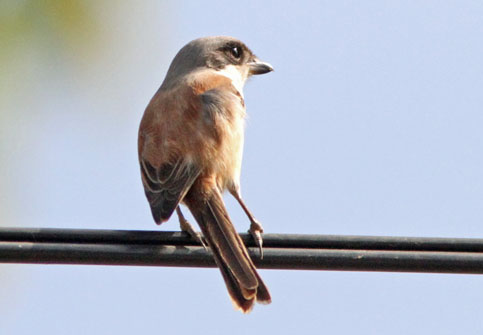| |
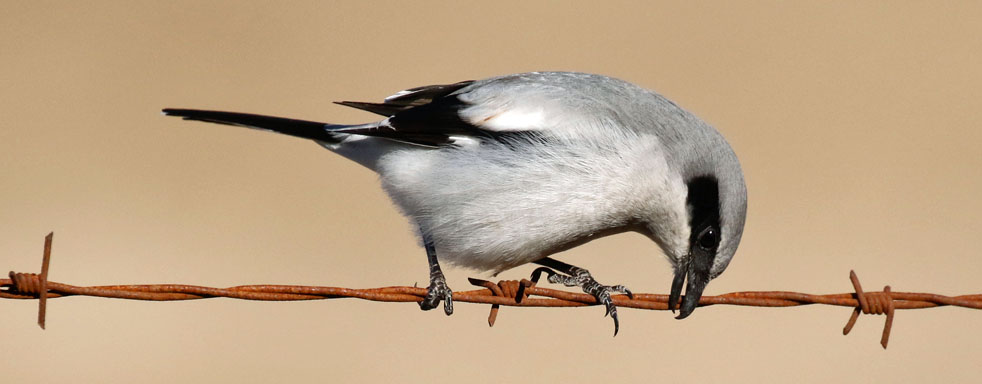 |
SHRIKES Laniidae |
- 31 species worldwide
- DR personal total: 26 species (84%), 20 photo'd
|
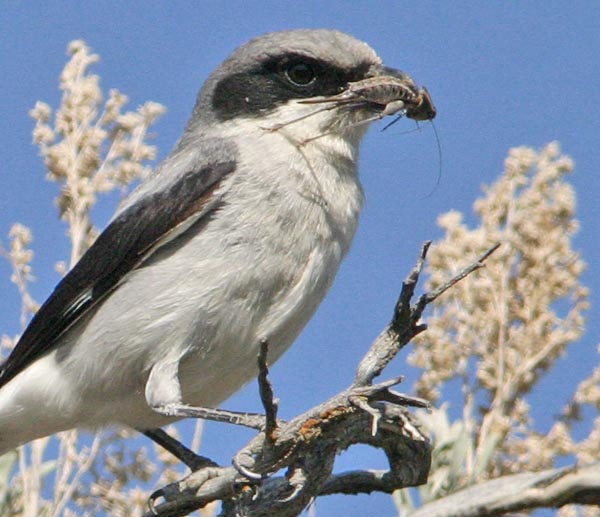 The true Shrikes are a widespread group of medium-sized predatory songbirds with hooked bills recalling raptors. Most are patterned crisply in gray, black and white but some include swathes of bay or chestnut. All but four of the Laniidae are currently assigned to the genus Lanius. All are generally solitary, monogamous, territorial birds. The true Shrikes are a widespread group of medium-sized predatory songbirds with hooked bills recalling raptors. Most are patterned crisply in gray, black and white but some include swathes of bay or chestnut. All but four of the Laniidae are currently assigned to the genus Lanius. All are generally solitary, monogamous, territorial birds.
Most true shrikes are birds of open country; an example is the widespread Loggerhead Shrike (above and left) of western North America. Some species are migratory but others in the tropics are resident. The Loggerhead Shrike is both: northern populations are migratory while many southern populations are not. They feed mostly on larger insects, like grasshoppers (see photo at left), but also small vertebrates like mice and lizards. Some species impale their prey on thorns or barbed wire for later retrieval. Their rapaciousness is legendary. A set of six shrikes from the African grasslands are called fiscals "from their rapacity, which no revenue-officer could exceed" (Fry & Keith 2000). |
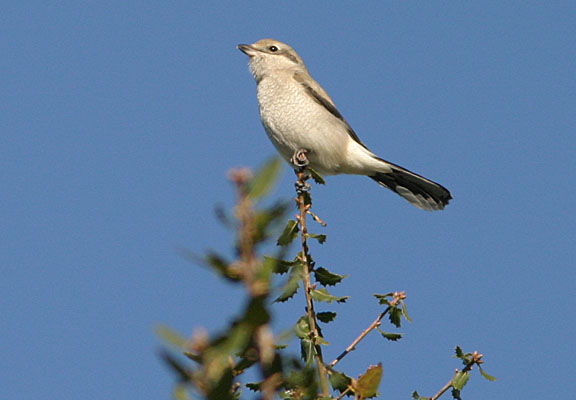 Almost all the shrikes are Old World species. Loggerhead Shrike is the only one restricted to the New World. Northern Shrike (right) has a circumpolar distribution, breeding widely but sparsely in taiga forests in both the Palearctic and Nearctic. In North America, Northern Shrike nests from Labrador and Quebec to western Alaska. Most of these breeders migrate south to southern Canada and northern United States during late fall and early winter. Winter irruptions are common, with peaks generally occurring every 3–6 years, but the reasons for such movements (e.g., cyclical populations of its small mammalian prey) are little understood (Harris 2000). It is the hatch-year birds in juvenal plumage that tend to go the farthest south, as to central California. The one shown (right) is one of those juvenal-plumaged individuals. it is perched on the top of the highest tree around, as do most Northern Shrikes, which studious avoid perching on barb-wire fences so often frequented by the smaller Loggerhead Shrike. Almost all the shrikes are Old World species. Loggerhead Shrike is the only one restricted to the New World. Northern Shrike (right) has a circumpolar distribution, breeding widely but sparsely in taiga forests in both the Palearctic and Nearctic. In North America, Northern Shrike nests from Labrador and Quebec to western Alaska. Most of these breeders migrate south to southern Canada and northern United States during late fall and early winter. Winter irruptions are common, with peaks generally occurring every 3–6 years, but the reasons for such movements (e.g., cyclical populations of its small mammalian prey) are little understood (Harris 2000). It is the hatch-year birds in juvenal plumage that tend to go the farthest south, as to central California. The one shown (right) is one of those juvenal-plumaged individuals. it is perched on the top of the highest tree around, as do most Northern Shrikes, which studious avoid perching on barb-wire fences so often frequented by the smaller Loggerhead Shrike. |
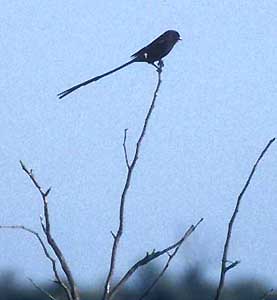 All shrikes are in the single genus Lanius. There are 18 Lanius shrikes in Eurasia, 12 Lanius shrikes in Africa, and just two (Loggerhead and Northern, the latter shared with Eurasia) in North America. [Two other African shrikes in genus Eurocephalus have been elevate them to Family status.] Assuming for the moment that the two Eurocephalus shrikes are retained in Laniidae, the family is divided between 58% of species that primarily breed in Eurasia (and its islands), 49% of species that primarily breed in Africa (and its islands), and Loggerhead Shrike inhabits North America. All shrikes are in the single genus Lanius. There are 18 Lanius shrikes in Eurasia, 12 Lanius shrikes in Africa, and just two (Loggerhead and Northern, the latter shared with Eurasia) in North America. [Two other African shrikes in genus Eurocephalus have been elevate them to Family status.] Assuming for the moment that the two Eurocephalus shrikes are retained in Laniidae, the family is divided between 58% of species that primarily breed in Eurasia (and its islands), 49% of species that primarily breed in Africa (and its islands), and Loggerhead Shrike inhabits North America.
Until recently, Yellow-billed Shrike was listed as Corvinella corvina — it ranges from west Africa and eastwards in a narrow sub-Saharan band west Kenya. Likewise, Magpie Shrike (left) was listed as Urolestes melanoleuca — it resides in southeast Africa. Both have very long tails but Magpie Shrike has a particularly striking one. They are also unique in their vocal duets, cooperative breeding behavior, and their gregariousness. They do not impale prey like Lanius shrikes (Harris 2000). However, Fuchs et al. (2019), using genetic evidence, found that Urolestes and Corvinella were both nested within genus Lanius. According, genus Lanius is expanded to 31 species, making behaviors a poor test of relationships.
Most members of Laniidae are termed "shrikes" in English, but seven African species are now known by the English name "fiscals." Most shrikes and fiscals are reasonable common, although some are quite local, and some are now rare. Newton's Fiscal Lanius newtoni is a critically endangered species endemic to the south end of São Tomé I. in the nation of São Tomé and Príncipe. |
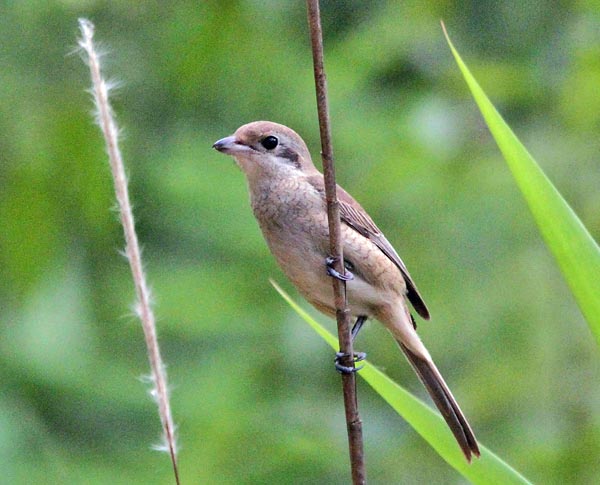 In Eurasia there is a suite of closely-related migratory shrikes. Brown Shrike (right) breeds throughout much of eastern Asia but migrates south to India, the Philippines, and Indonesia. This bird (right), on its wintering grounds in Thailand, is a female or immature because of its barred flanks. Long-distance migrants will occasionally turn up as vagrants a very long ways from normal haunts. This first-cycle Brown Shrike (below, a digiscoped shot) wintered in Humboldt Co., California, USA in winter 2010-2011. It was just the 3rd record for California. In Eurasia there is a suite of closely-related migratory shrikes. Brown Shrike (right) breeds throughout much of eastern Asia but migrates south to India, the Philippines, and Indonesia. This bird (right), on its wintering grounds in Thailand, is a female or immature because of its barred flanks. Long-distance migrants will occasionally turn up as vagrants a very long ways from normal haunts. This first-cycle Brown Shrike (below, a digiscoped shot) wintered in Humboldt Co., California, USA in winter 2010-2011. It was just the 3rd record for California.
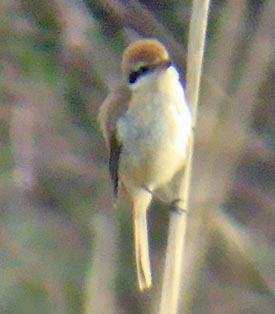
|
 |
|  Shrikes are generally sit-and-wait predators, swooping down from elevated perches to grab prey on the ground. These patterns and behaviors are common among the Lanius shrikes around the world. Bay-backed Shrike (left) inhabits dry thorn-scrub country on the Indian subcontinent and west to Iran, and north to southern Russia. Except for its northwestern populations, it is generally a resident species It, like almost all the Lanius shrikes, has a black mask (ear-coverts, lores and often forecrown) and is crisply patterned in gray, black and white. Adult Bay-backs have maroon-chestnut mantles. Shrikes are generally sit-and-wait predators, swooping down from elevated perches to grab prey on the ground. These patterns and behaviors are common among the Lanius shrikes around the world. Bay-backed Shrike (left) inhabits dry thorn-scrub country on the Indian subcontinent and west to Iran, and north to southern Russia. Except for its northwestern populations, it is generally a resident species It, like almost all the Lanius shrikes, has a black mask (ear-coverts, lores and often forecrown) and is crisply patterned in gray, black and white. Adult Bay-backs have maroon-chestnut mantles.
The young of many species, though, are barred with brown and much less conspicuous. One good example is Tiger Shrike (above). This is a young Tiger Shrike wintering in Malaysia, where its barred patterns make it less noticeable in the forest. Young Tiger Shrikes are known by their "big-eyed" appearance. |
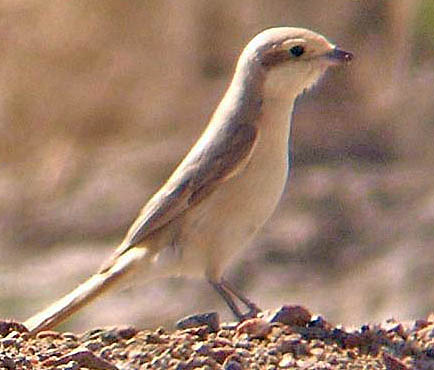 |
Isabelline Shrike (left) is a long-distance migrant from central Asia. It has multiple races, but this pale one, on the Qinghai Plateau of China, is likely the pale race tsaidamensis, which migrates as far as Pakistan. Populations from central Asia migrate as far as north Africa to winter.
Red-tailed Shrike (right), often called Turkestan Shrike, is also a central Asian breeder that moves to Arabia and east Africa. This spring migrant perched atop a sprinkler head at a camel race-track in the United Arab Emirates. |
 |
|
In March–April 2015, a wintering Asian shrike in Mendocino Co., California, provided excitement and uncertainty. Initially thought to perhaps a Brown Shrike, it became problematic as shrike in the Red-backed/Isabelline set [L. collurio / isabellinus] set, or even a hybrid, were considered. It was in active tail and body molt in April 2015, and a full determination may require the conclusion of the molt. I took these shots but when it had left, no one knew what it was.
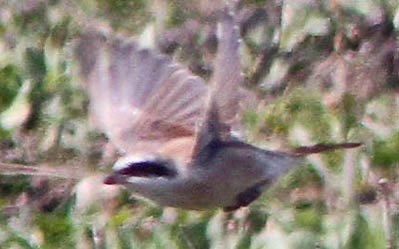
|
|
The conclusion of an extensive research effort was published later in the year by Pyle et al. (2015). The abstract of the paper reads: "Red-backed (Lanius collurio), Turkestan (or Red-tailed, L. phoenicuroides), Isabelline (L. isabellinus), and Brown (L. cristatus) Shrikes comprise an assemblage of related species that breed, migrate, and winter throughout the Old World. The group includes five or more subspecies, and hybridization between Red-backed Shrike and each of the other species is known to occur. An individual of this assemblage was observed at the mouth of Alder Creek, Mendocino County, California, from 5 March through 22 April 2015. In an effort to identify this shrike, we analyzed more than 500 digital images and examined more than 900 specimens to assess variation in molts, plumages, and age/sex-determination criteria. . . . Although uncertainty is unavoidable when attempting to identify hybrids, we believe that plumage features, along with perhaps more telling wing and tail structural morphologies, point to Red-backed x Turkestan Shrike hybrid as the identification of the Mendocino bird. We also consider how such a hybrid, from a limited breeding area that extends from the Caspian Sea to the Altai region of south-central Russia, might reach California via reverse migration (180º misorientation)." Along with many others, I contributed my photos to the research effort, and some of them were published in the paper. That in the end it was identified as most likely a Red-backed x Red-tailed Shrike hybrid (two photos above), a birder gets no points for hybrids. Neither Red-backed nor Red-tailed is added to the State list. One might think we should get "double points" for such an amazing bird, but bird-listing is a cruel mistress. At least is adds something to discussion of the Brown/Isabelline/Red-tailed/Red-backed group of central Asian shrikes for this modest page. |
Another fine migrant shrike was encountered in the U.A.E. during a March visit in 2001. Masked Shrike (near right) of Asia Minor is among the most lovely and distinctive shrikes. It breeds locally from Greece to Iran and winters to northeast Africa and Arabia. Seeing this one was an unexpected treat.
In the deserts of the Sinai Peninsula in 1981, I encountered this inquisitive shrike, thought at the time to be "Southern Gray Shrike L. meriodionalis." Now, however, after genetic research, L. meriodionalis is now the Iberian Gray Shrike, restricted to the Iberian Peninsula in Europe. This desert shrike becomes part of more widespread species, Great Gray Shrike (right; spelt Great Grey Shrike in the British Commonwealth). For the moment, Great Gray Shrike is a species ranging from continental Europe to north Africa and the Middle East. Some populations are migratory and others are not. The subspecies in the Sinai would be aucheri, considered part of the "Arabian" group of Great Gray Shrikes. There may be more taxonomic changes to come. |
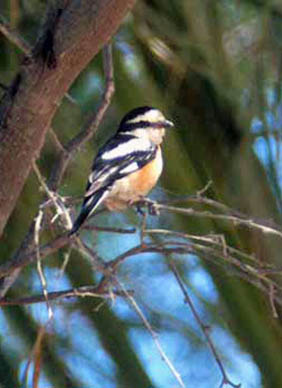 |
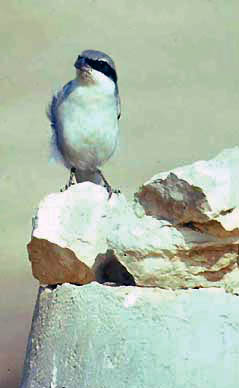 |
|
|
The Gray-backed Shrike (above left) is a small, higher elevation version of the widespread Long-tailed Shrike (which is discussed below). They were once lumped as one species, but the two taxa are largely sympatric. As a high-elevation bird, nesting in montane meadows in the Himalayas and China, it moves downslope in winter, frequenting grasslands from eastern India to Indochina. Mountain Shrike (above right) is similar in plumage but is larger and lacks the rufous rump of Gray-backed. It is a Philippine endemic in mossy cloud forest from 1200–2400m (4000–8000'), and generally scarce and local on Luzon, Mindoro, and Mindanao. In any event, seeing Gray-backed Shrike in Kaziranga NP, India, was easy in winter; seeing a resident Mountain Shrike in the Philippines was hard to find and exciting.
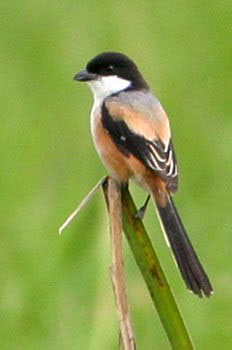 |
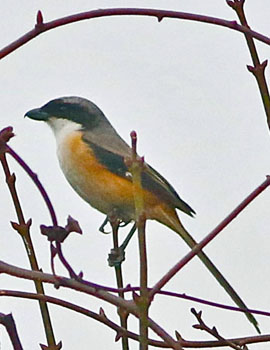 |
While taxonomy and hybridization are confusing aspect of some Asian shrikes, it is the variation within Long-tailed Shrike (two photos at left) that requires a depth of knowledge. It is generally a widespread and often resident species, although northern populations are migratory. There are currently 8 subspecies and 5 "groups" in Clements' current (2020) checklist. It is an open country shrike, and thus often easy to spot.
The Philippine race nasutus (far left) has an all-black head and nape, white throat, and a gray and rufous back. The resident subspecies tricolor, in Nepal, east India, and China has a similar color scheme, and we became familiar with it on a trip to Bhutan.
So when we encountered this gray-capped and gray-backed Long-tailed Shrike in Bhutan in March (near left), it was evident that it was a migrant heading northeast, and comparatively scarce for Bhutan. It was the northwest race erythronotus, and likely was heading towards breeding grounds somewhere between Afghanistan & Kazakhstan. |
|
|
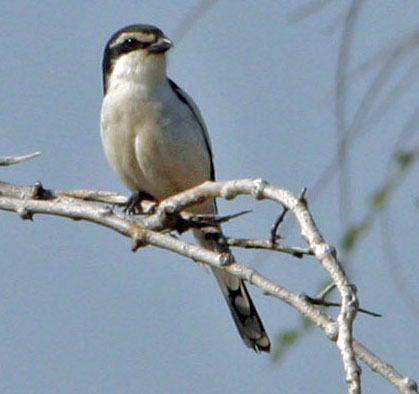 Africa has 14 shrikes (unless the two species in genus Eurocephalus should be in another family; see below). Of the 14 species, 7 are called "shrikes" and 7 are called "fiscals," at least under current taxonomy. MacKinnon's Shrike (above left) is a forest bird, at edges or in small meadows, whose range is in the eastern and western ends of the Congo Basin, but not in the middle. Taita Fiscal (above right) is a bird of open thornscrub in east Africa. This adult had prey in its beak but it seemed to me to be doing an open-wing display — perhaps a courtship display? Africa has 14 shrikes (unless the two species in genus Eurocephalus should be in another family; see below). Of the 14 species, 7 are called "shrikes" and 7 are called "fiscals," at least under current taxonomy. MacKinnon's Shrike (above left) is a forest bird, at edges or in small meadows, whose range is in the eastern and western ends of the Congo Basin, but not in the middle. Taita Fiscal (above right) is a bird of open thornscrub in east Africa. This adult had prey in its beak but it seemed to me to be doing an open-wing display — perhaps a courtship display?
One of the most widespread and well-known passerines in sub-Saharan Africa used to be "Fiscal Shrike" L. collaris (Fry & Keith 2000). It was often the resident and most-often seen shrike in open country. Then Fuchs et al. (2011), using molecular evidence, studied the biogeography of this taxa, and determined that there were two species. These became what we now know as Southern Fiscal (right) and Northern Fiscal L. humeralis. Southern Fiscal's range encompasses southern Africa from Angola and Zimbabwe. Northern Fiscal ranges across the continent south of the Sahara and north of the range of Southern Fiscal. The ranges overlap mostly in Tanzania, with Southern Fiscal (race marwitzi) a higher-elevation taxon in mountains of mostly central and southern Tanzania, and Northern Fiscal widespread below those elevations. Most subspecies of Southern Fiscal have a white supercilium; Northern lacks this feature.
Long-tailed Fiscal (below) is an east African species of open country, pretty much restricted to Tanzania and Kenya (it reaches south Somalia). It is not only long-tailed but a largish, lanky shrike that can routinely take lizards, snakes, and small birds, in addition to invertebrate prey. It hunts from high perches but prey is usually captured on the ground (Yosef 2008).With buff-edgings to crown and upperwing coverts, this individual (below) appears to be in juvenal plumage. |
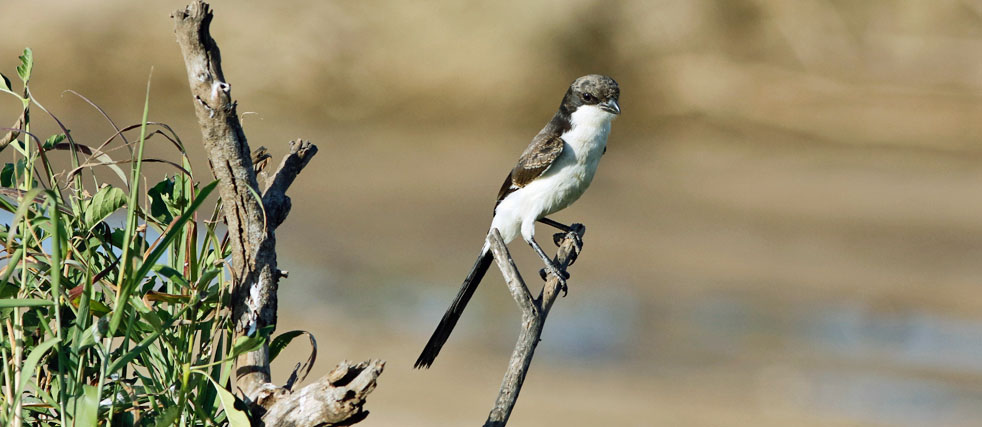 |
|
Shrikes can be shy and avoid close approach, but as (generally) open country species, can often be photographed comparatively easily with a long lens. Small and medium-sized shrikes often sit atop bushes, or on fence lines or power lines. This Burmese Shrike (above left) breeds in open areas in Asia from Myanmar (Burma) to China and n. Vietnam, and then winters from e. India and throughout southeast Asia. It is a striking gray-headed, red-backed spices, and here it perches on a power line in Thailand in winter. Many shrikes have a distinctive juvenal plumage that is barred and rusty, as mentioned above. Here is another example (above right): a fledgling Northern Fiscal in the lowlands of northern Tanzania.
Some taxonomic background: The following text is restated from my original page on Laniidae some 20 years ago, when the taxonomic position of shrikes was uncertain. I've updated the discussion in the final lines.
As recently as the 1990s, true shrikes were considered to be close relatives of Bush-Shrikes (Malaconotidae), Helmet-Shrikes (Prionopinae), Vangas (Vangidae), and the Batises & Wattle-eyes (Platysteiridae). Indeed, much of the older literature lumps these groups with the Laniidae. Harris & Franklin (2000) published a major family tome whose premise was that these groups were each others' closest relatives. Some authors (e.g., Sibley & Ahlquist 1990), working with DNA-DNA hybridization, placed the helmet-shrikes with the wattle-eyes and the vangas, in a single "tribe" of the bush-shrike "subfamily" within a bulging corvid assemblage. Collar et al. (1994), following suggestions of Dowsett & Dowsett-Lemaire (1993), lumped the helmet-shrikes and bush-shrikes with the world's regular shrikes in the Laniidae, but separated out the vangas, and placed the wattle-eyes some distance away near the monarch-flycatchers! It was all very confusing. Relationship are now much better resolved. Fuchs et al. (2004), working with DNA sequencing, found that all the 'bush-shrike' families [e.g., Bush-Shrikes (Malaconotidae), Vangas (Vangidae), and the Batises & Wattle-eyes (Platysteiridae)] grouped together as a real evolutionary unit, but the same sort of biochemical evidence shows that the true Shrikes (Laniidae) are not their closest relatives (e.g., Barker et al. 2004). Rather, although both groups are "core Corvoidea," the true Shrikes are more closely related to Crows and relatives [Corvidae], while the Bush-shrikes are more closely related to Wood-Swallows and Butcherbirds, among others. More recently, Jønsson et al. (2012) and Reddy et al. (2012) determined that helmet-shrikes and wood-shrikes were part of the Vanga assemblage, and these groups became subfamilies within an enlarged Vangidae.
New taxonomy: Fuchs et al. (2019) recently opined that Laniidae should be reduced to 31 species of Lanius shrikes alone, merging Corvinella and Urolestes into Lanius, and spinning off the two Eurocephalus shrikes to another family or elevating them to their own Family status. We shall see if those proposals are adopted in due course; I have tentatively accepted the White-crowned Shrikes as a new Family. |
| |
Photos: The Loggerhead Shrike Lanius ludovicianus was near King City, Monterey Co., California, USA, on 27 Nov 2020; the grasshopper-catching Loggerhead Shrike was at Sand Creek, Modoc Co., California, on 8 June 2007. The young Northern Shrike Lanius borealis was along Pleasant Valley Rd., Solano Co., California, USA, on 15 Jan 2006. The Magpie Shrike Lanius melanoleucus was in Kruger NP, South Africa, on 30 July 1996. The wintering Brown Shrike Lanius cristatus was in Kaeng Krachan NP, Thailand, on 23 Dec 2012; the digiscoped vagrant was near McKinleyville, Humboldt Co., California, on 10 Jan 2011. The Tiger Shrike Lanius ludovicianus was in the Panti Forest, Malaysia, on 24 Sep 2011. The Bay-backed Shrike Lanius vittatus was at the Tiger Moon Resort near Ranthambore, Rajasthan, India, on 25 Mar 2001. The Isabelline Shrike Lanius isabellinus, of the "Chinese" group, was on the Qinghai Plateau, China, on 19 June 2004. The migrant Red-tailed Shrike Lanius phoenicuroides was at the Al Wathba camel track, United Arab Emirates, on 6 Mar 2001. The two photos of an apparent hybrid Red-backed x Red-tailed Shrike Lanius collurio x phoenicuroides were taken at the Alder Creek mouth, Mendocino Co., California, USA, on 3 Apr 2015. The Masked Shrike Lanius nubicus was n Abu Dhabi, United Arab Emirates, on 7 Mar 2001. The Great Gray Shrike Lanius excubitor aucheri was on the Sinai Peninsula, Egypt, in Oct 1981. The Gray-backed Shrike Lanius tephronotus was in Kaziranga NP, Assam, India, on 13 Mar 2019. The Mountain Shrike Lanius validirostris was Mt. Pollis, Luzon, Philippines, on 31 Dec 2005. The Long-tailed Shrike Lanius schach, of the Philippine race nasutus, was in the Candaba marsh, Luzon, Philippines, on 30 Dec 2005; the migrant of race erythronotus was at Chendebji, Bhutan, on 30 Mar 2019. The MacKinnon's Shrike Lanius mackinnoni was in the Kakamega Forest NR, Kenya, on 20 Nov 1981. The Taita Fiscal Lanius dorsalis was at Engikaret, Arusha, Tanzania, on 7 June 2018. The Southern Fiscal Lanius collaris was Augrabies Falls NP, South Africa, on 9 July 2005. The Long-tailed Fiscal Lanius cabanisi was in Tarangire NP, Tanzania, on 9 June 2018. The Burmese Shrike Lanius collurioides was at Sab Sadao Ranger Station, Thailand, on 27 Dec 2012. The Northern Fiscal Lanius humeralis was near the town of Usa, n. Tanzania, on 6 June 2018.
All photos © Don Roberson; all rights reserved.
Family Book: Rating: 
Harris, Tony. 2000. Shrikes & Bush-Shrikes. Illustrations by Kim Franklin. Princeton Univ. Press, Princeton, N.J.
This is a very attractive offering in the Princeton bird families series. Tony Harris wrote the text; Kim Franklin painted the plates. It has the familiar layout of plates altogether in the front, with range maps and i.d. summary, and detailed species accounts in the back. It looks well researched and has a good bibliography. I very much enjoyed the full-page spreads, with black-and-white sketch, on each genus in the groups covered, that highlights the introduction. There is a lot of discussion of taxonomy but, unfortunately, the authors chose to follow the Sibley & Ahlquist (1990) approach of only two families: shrikes [Laniidae] and bush-shrikes [Malaconotidae]. All of the batises, wattle-eyes, helmet shrikes, and such things as flycatcher-shrikes, wood-shrikes, and philentomas, are thrown into the latter family. New research does not support this approach. As it turns out, the true shrikes are not the closest relatives to the rest of this set (e.g., Barker et al. 2004), so even the premise of this book proves false. Further, vangas (not included in this book) are closely related to the rest of the group. Indeed, it appears that the flycatcher-shrikes are vangas, and that helmet-shrikes are very closely related to vangas. The text also suffers from the author's use of the "Species Recognition Concept" as his definition for species; fortunately, in practice, in works rather like the tried-and-true "Biological Species Concept." Yet both in its language and in its reliance on DNA hybridization evidence (Sibley & Ahlquist 1990), this book has the unfortunate status of being out-of-date taxonomically much more quickly than would be anticipated.
That having been said, the species accounts, maps, and paintings for the species that are included all are very good. This is a well-written book with attractive paintings. It is great to have a world overview of the species that are included, even if they do not hang together as a group. One major annoyance: citations in the text are small-print superscript numbers. A list of these numbers is in the back of the book, but the list does not give the full citation. Rather, citation number 732 is "Emlen 1979." One then has to go check the bibliography to locate the full citation to Emlen's note in Scopus on fiscal shrikes. This is an entirely unnecessary double effort for the reader, and should have been fixed by the publisher (just number the bibliography if you use this tactic; see Dickinson 2003 for an example of the proper way to do this). Despite all these criticisms, it IS a very attractive publication and quite useful in many ways. So I give it 4 (of 5) stars despite its limitations. The basic, underlying information about each taxa, and the attractive plates, make up for a lot.
In addition, I should mention that there is an earlier book focused just on this family: Norbert Lefranc & Tim Worfolk's (1997) A Guide to Shrikes of the World. Alas, I never read that book in any detail but my first impression in a book store was positive. In addition, the Laniidae section in the Birds of Africa series (Fry & Keith 2000) has a excellent introduction to the African species, as is Yosef (2008) for a worldwide overview.
Literature cited:
Barker, F.K., A. Cibois, P. Schikler, J. Feinstein, and J. Cracraft. 2004. Phylogeny and diversification of the largest avian radiation. Proc. Nat. Acad. Sci. 101: 11040–11045.
Collar, N.J., M.J. Crosby, and A.J. Stattersfield. 1994. Birds to Watch 2: The World List of Threatened Birds. Birdlife Conserv. Ser. 4. Birdlife Intern'l, Smithsonian Inst., Washington, D.C.
Dowsett, R.J., and F. Dowsett-Lemaire. 1993. "Comments on the taxonomy of some Afrotropical bird species," pp. 232–389 in A Contribution to the Distribution and Taxonomy of Afrotropical and Malagasy Birds (R. J. Dowsett & F. Dowsett-Lemaire, eds.). Tauraco Res. Rpt. 5. Tauraco Press, Liége.
Fry, C.H., and S. Keith, eds. 2000. The Birds of Africa. Vol. 6. Academic Press, London.
Fuchs, J., P. Alström, R. Yosef, and U. Olsson. 2019. Miocene diversification of an open-habitat predatorial passerine radiation, the shrikes (Aves: Passeriformes: Laniidae). Zoologica Scripta, 48: 571–588.
Fuchs, J., R.C.K. Bowie, J. Fjeldsa, and E. Pasquet. 2004. Phylogenetic relationships of the African bush-shrikes and helmet-shrikes (Passeriformes: Malaconotidae). Molec. Phylog. Evol. 33: 428–439.
Fuchs, J., T.M. Crowe, and C.K. Bowie. 2011. Phylogeography of the fiscal shrike (Lanius collaris): a novel pattern of genetic structure across the arid zones and savannas of Africa. J. Biogeography 38: 2210–2222.
Jønsson, K.A., P-H. Fabre, S.A. Fritz, R.S. Etienne, R.E. Ricklefs, T.B. Jørgensen, J. Fjeldså, C. Rahbek, P.G.P. Ericson, F. Woog, E. Pasquet, and M. Irestedt. 2012. Ecological and evolutionary determinants for the adaptive radiation of the Madagascan vangas. PNAS: 1115835109.
Pyle, P., R.J. Keiffer, J. Dunn, and N. Moores. 2015. The Mendocino Shrike: Red-backed Shrike (Lanius collurio) x Turkestan Shrike (L. phoenicuroides) hybrid. North Amer. Birds 69: 4–35.
Reddy, S., A. Driskell, D.L. Rabosky, S.J. Hackett, and T.S. Schulenberg. 2012. Diversification and the adaptive radiation of the vangas of Madagascar, Proc. Royal Soc. B 279: 2062–2071.
Sibley, C.G., and J.E. Ahlquist. 1990. Phylogeny and Classification of Birds: A Study in Molecular Evolution. Yale Univ. Press, New Haven, CT.
Yosef, R. 2008. Family Laniidae (Shrikes), pp. 732–782 in Handbook of the Birds of the World (del Hoyo, J., A. Elliott & D. Christie, eds). Vol. 13. Lynx Edicions, Barcelona, Spain.
Zimmerman, D.A., D.A. Turner, and D.J. Pearson. 1996. Birds of Kenya and northern Tanzania. Christopher Helm, London.
|
|
|


 Almost all the shrikes are Old World species. Loggerhead Shrike is the only one restricted to the New World. Northern Shrike (right) has a circumpolar distribution, breeding widely but sparsely in taiga forests in both the Palearctic and Nearctic. In North America, Northern Shrike nests from Labrador and Quebec to western Alaska. Most of these breeders migrate south to southern Canada and northern United States during late fall and early winter. Winter irruptions are common, with peaks generally occurring every 3–6 years, but the reasons for such movements (e.g., cyclical populations of its small mammalian prey) are little understood (Harris 2000). It is the hatch-year birds in juvenal plumage that tend to go the farthest south, as to central California. The one shown (right) is one of those juvenal-plumaged individuals. it is perched on the top of the highest tree around, as do most Northern Shrikes, which studious avoid perching on barb-wire fences so often frequented by the smaller Loggerhead Shrike.
Almost all the shrikes are Old World species. Loggerhead Shrike is the only one restricted to the New World. Northern Shrike (right) has a circumpolar distribution, breeding widely but sparsely in taiga forests in both the Palearctic and Nearctic. In North America, Northern Shrike nests from Labrador and Quebec to western Alaska. Most of these breeders migrate south to southern Canada and northern United States during late fall and early winter. Winter irruptions are common, with peaks generally occurring every 3–6 years, but the reasons for such movements (e.g., cyclical populations of its small mammalian prey) are little understood (Harris 2000). It is the hatch-year birds in juvenal plumage that tend to go the farthest south, as to central California. The one shown (right) is one of those juvenal-plumaged individuals. it is perched on the top of the highest tree around, as do most Northern Shrikes, which studious avoid perching on barb-wire fences so often frequented by the smaller Loggerhead Shrike.

 The true Shrikes are a widespread group of medium-sized predatory songbirds with hooked bills recalling raptors. Most are patterned crisply in gray, black and white but some include swathes of bay or chestnut. All but four of the Laniidae are currently assigned to the genus Lanius. All are generally solitary, monogamous, territorial birds.
The true Shrikes are a widespread group of medium-sized predatory songbirds with hooked bills recalling raptors. Most are patterned crisply in gray, black and white but some include swathes of bay or chestnut. All but four of the Laniidae are currently assigned to the genus Lanius. All are generally solitary, monogamous, territorial birds.  All shrikes are in the single genus Lanius. There are 18 Lanius shrikes in Eurasia, 12 Lanius shrikes in Africa, and just two (Loggerhead and Northern, the latter shared with Eurasia) in North America. [Two other African shrikes in genus Eurocephalus have been elevate them to Family status.] Assuming for the moment that the two Eurocephalus shrikes are retained in Laniidae, the family is divided between 58% of species that primarily breed in Eurasia (and its islands), 49% of species that primarily breed in Africa (and its islands), and Loggerhead Shrike inhabits North America.
All shrikes are in the single genus Lanius. There are 18 Lanius shrikes in Eurasia, 12 Lanius shrikes in Africa, and just two (Loggerhead and Northern, the latter shared with Eurasia) in North America. [Two other African shrikes in genus Eurocephalus have been elevate them to Family status.] Assuming for the moment that the two Eurocephalus shrikes are retained in Laniidae, the family is divided between 58% of species that primarily breed in Eurasia (and its islands), 49% of species that primarily breed in Africa (and its islands), and Loggerhead Shrike inhabits North America.  In Eurasia there is a suite of closely-related migratory shrikes. Brown Shrike (right) breeds throughout much of eastern Asia but migrates south to India, the Philippines, and Indonesia. This bird (right), on its wintering grounds in Thailand, is a female or immature because of its barred flanks. Long-distance migrants will occasionally turn up as vagrants a very long ways from normal haunts. This first-cycle Brown Shrike (below, a digiscoped shot) wintered in Humboldt Co., California, USA in winter 2010-2011. It was just the 3rd record for California.
In Eurasia there is a suite of closely-related migratory shrikes. Brown Shrike (right) breeds throughout much of eastern Asia but migrates south to India, the Philippines, and Indonesia. This bird (right), on its wintering grounds in Thailand, is a female or immature because of its barred flanks. Long-distance migrants will occasionally turn up as vagrants a very long ways from normal haunts. This first-cycle Brown Shrike (below, a digiscoped shot) wintered in Humboldt Co., California, USA in winter 2010-2011. It was just the 3rd record for California.
 Shrikes are generally sit-and-wait predators, swooping down from elevated perches to grab prey on the ground. These patterns and behaviors are common among the Lanius shrikes around the world. Bay-backed Shrike (left) inhabits dry thorn-scrub country on the Indian subcontinent and west to Iran, and north to southern Russia. Except for its northwestern populations, it is generally a resident species It, like almost all the Lanius shrikes, has a black mask (ear-coverts, lores and often forecrown) and is crisply patterned in gray, black and white. Adult Bay-backs have maroon-chestnut mantles.
Shrikes are generally sit-and-wait predators, swooping down from elevated perches to grab prey on the ground. These patterns and behaviors are common among the Lanius shrikes around the world. Bay-backed Shrike (left) inhabits dry thorn-scrub country on the Indian subcontinent and west to Iran, and north to southern Russia. Except for its northwestern populations, it is generally a resident species It, like almost all the Lanius shrikes, has a black mask (ear-coverts, lores and often forecrown) and is crisply patterned in gray, black and white. Adult Bay-backs have maroon-chestnut mantles. 


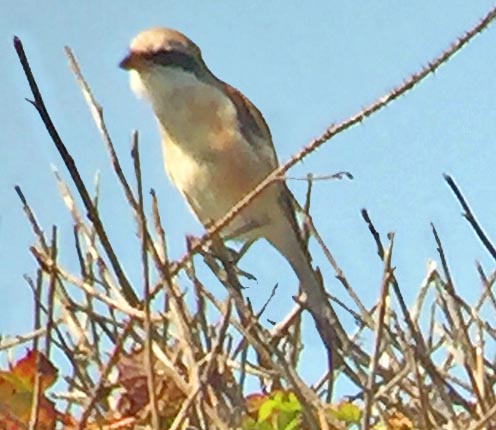


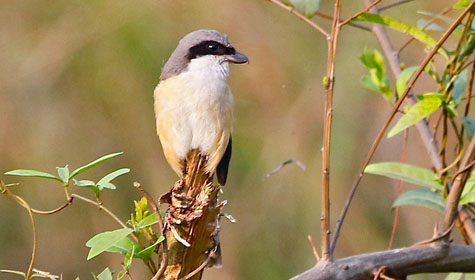
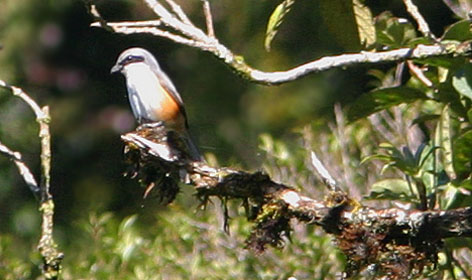


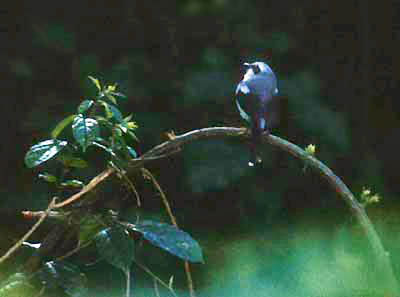
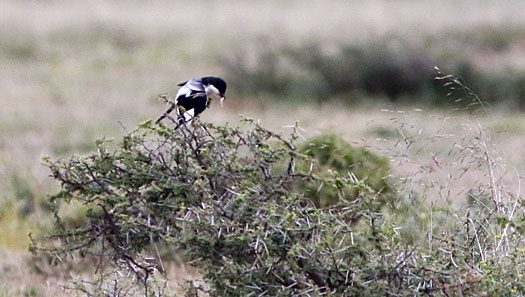
 Africa has 14 shrikes (unless the two species in genus Eurocephalus should be in another family; see below). Of the 14 species, 7 are called "shrikes" and 7 are called "fiscals," at least under current taxonomy. MacKinnon's Shrike (above left) is a forest bird, at edges or in small meadows, whose range is in the eastern and western ends of the Congo Basin, but not in the middle. Taita Fiscal (above right) is a bird of open thornscrub in east Africa. This adult had prey in its beak but it seemed to me to be doing an open-wing display — perhaps a courtship display?
Africa has 14 shrikes (unless the two species in genus Eurocephalus should be in another family; see below). Of the 14 species, 7 are called "shrikes" and 7 are called "fiscals," at least under current taxonomy. MacKinnon's Shrike (above left) is a forest bird, at edges or in small meadows, whose range is in the eastern and western ends of the Congo Basin, but not in the middle. Taita Fiscal (above right) is a bird of open thornscrub in east Africa. This adult had prey in its beak but it seemed to me to be doing an open-wing display — perhaps a courtship display?